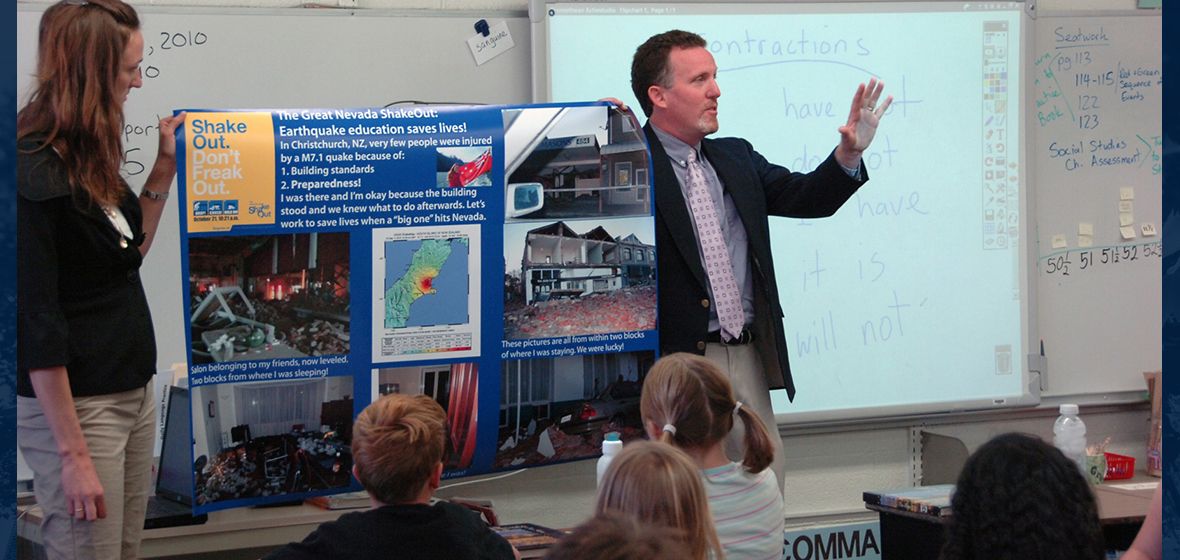As the University of Nevada, Reno continues to grow, so does the need for more on-campus housing. One of the many considerations in the University's long-term student housing plan is how to bring the full offering of on-campus housing options in line with modern construction standards. Because Nevada is the nation's third most seismically active state, it's a relevant consideration.
The University is already looking beyond the next two student-housing options under construction - a new residence hall on North Sierra Street and Ponderosa Village on Evans Avenue - and outlining the concept for an additional large-capacity residence hall anticipated to open in fall 2017. Developed in consultation with faculty experts in seismology and engineering, the concept considers the future of Lincoln and Manzanita Halls, built in 1894 and 1895 with walls using a construction method known as unreinforced masonry and with timber floors. Not surprisingly, newer construction methods and standards exceed the seismic performance of URM construction, as it is known.
"Not only is our campus enrollment growing, but we are also seeing an increased interest for on-campus housing options, particularly among freshmen," Jerry Marczynski, associate vice president of Student Life Services, said. "To meet this demand, we must continue to take a long-term view of our on-campus housing. It is our goal to have 100 percent of our residence-hall options be facilities built to modern construction standards."
Proposed, 2017 Residence Hall
The concept for the proposed 2017 residence hall, which may house up to 400 students and would be funded through residence hall fees, includes these key elements:
- It would be located on the west side of the new William N. Pennington Student Achievement Center in the area now home to White Pine and Lincoln Hall.
- Its design would blend preservation with new construction. For example, from the south the facility would maintain the historic look of campus by carrying forward exterior, architectural characteristics of Lincoln Hall such as the entrance, porch, dormers and/or cupola. However, the interior of the entire building is proposed to be new construction.
- To make way for the project, White Pine Hall would be removed completely and Lincoln Hall would be removed other than architectural characteristics as described above.
Manzanita Hall will also be evaluated as part of the long-term planning for student housing. Possible future options include re-purposing the facility to a less intensive use or removal.
With these adjustments to the long-term plan, the three residence halls - Lincoln, Manzanita and White Pine - will continue to be used for student housing until June 30, 2015, when they will close to residence-hall use. In the meantime, construction treatments to improve seismic performance are being planned.
"It's a win-win situation: we get additional, much needed on-campus student housing and are retiring some of the seismically underperforming buildings on campus," Graham Kent, director of the Nevada Seismological Laboratory and one of the faculty members asked to contribute to the planning, said.
"This direction lets us address long-term housing expansion plans, allows us to address the seismic issues of the old buildings and gives us a framework for evaluating the other seismically challenged buildings on campus."
The University has addressed the seismic performance of several buildings on campus. The Frandsen Humanities and Mackay Mines buildings have been seismically retrofitted and seismic performance was one of the factors considered in the decision to remove the Getchell building to make way for the Pennington Student Achievement Center. Short-term and long-term actions are also being identified and evaluated for other older, URM-construction buildings on campus.
Earthquake Safety and Awareness Initiative
The region of Nevada and Eastern California has a history of damaging earthquakes, and Kent and the Nevada Seismological Laboratory team advise that no matter where one lives or works, earthquake preparedness should be top-of-mind. They introduced the Great Nevada ShakeOut in 2010, part of a worldwide public earthquake drill, and have taken the program statewide.
The Great Nevada ShakeOut is an annual opportunity to practice how to be safer during big earthquakes. It encourages everyone and all organizations, including schools and businesses, to review and update emergency preparedness plans and supplies, and to secure spaces in order to prevent damage and injuries. Research has shown that most earthquake injuries are the result of falling items, such as furniture, heavy pictures, mirrors or glass.
Next fall, involvement in the Great Nevada ShakeOut will be further emphasized for the University community.
"Our first line of defense is helping people learn how to respond properly in an earthquake, especially in older buildings," Kent said, and he further noted there are up to 8,700 buildings of URM construction in northern Nevada and more than 23,000 across the state.
While the best way to respond in an earthquake can be conditional, experts advise the "drop, cover and hold on" response for most earthquake situations.
"We have appreciated the contribution of faculty expertise to our planning process," Marczynski said. "Addressing seismic issues has long been an objective for the University and we have the opportunity to take important steps toward this objective as we plan to meet the growing demand for on-campus living."
For more information about earthquake preparedness, visit the Great Nevada Shakeout website at http://www.shakeout.org/nevada/.












